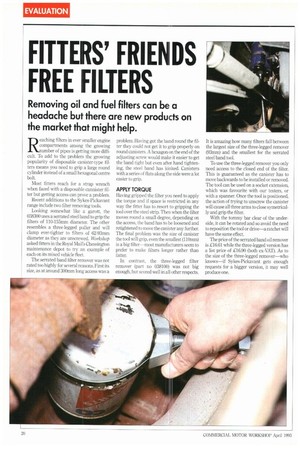FITTERS' FRIENDS FREE FILTERS
Page 104

If you've noticed an error in this article please click here to report it so we can fix it.
Removing oil and fuel filters can be a headache but there are new products on the market that might help.
Rcaching filters in ever smaller engine compartments among the growing lumber of pipes is getting more difficult. TO add to the problem the growing popularity of disposable canister-type filters means you need to grip a large round cylinder instead of a small hexagonal centre bolt.
Most fitters reach for a strap wrench when faced with a disposable cannister filter but getting access can prove a problem.
Recent additions to the Sykes-Pickavant range include two filter removing tools.
Looking somewhat like a garott. the 038300 uses a serrated steel band to grip the filters of 110-155mm diameter. The other resembles a three-legged puller and will clamp ever-tighter to filters of 62-93mm diameter as they are unscrewed. Workshop asked fitters in the Royal Mail's Chessing-ton maintenance depot to try an example of each on its mixed vehicle fleet.
The serrated band filter remover was not rated too highly for several reasons. First its size, as at around 300mm long access was a problem. Having got the band round the filter they could not get it to grip properly on round canisters. A hexagon on the end of the adjusting screw would make it easier to get the band tight but even after hand tightening, the steel band has kinked. Canisters with a series of flats along the side were a lot easier to grip.
APPLY TORQUE Having grip; . the filter you need to apply the torque and if space is restricted in any way the fitter has to resort to gripping the tool over the steel strip. Then when the filter moves round a small degree, depending on the access, the band has to be loosened and retightened to move the canister any further. The final problem was the size of canister the tool will grip, even the smallest (110mm) is a big filter—most manufacturers seem to prefer to make filters longer rather than fatter.
In contrast, the three-legged filter remover (part no 038100) was not big enough, but scored well in all other respects. It is amazing how many filters fall between the largest size of the three-legged remover (93mm) and the smallest for the serrated steel band tool.
To use the three-legged remover you only need access to the closed end of the filter. This is guaranteed as the canister has to move backwards to be installed or removed. The tool can be used on a socket extension, which was favourite with our testers, or with a spanner. Once the tool is positioned, the action of trying to unscrew the canister will cause all three arms to close symetriailly and grip the filter.
With the tommy bar clear of the underside, it can be rotated and so avoid the need to reposition the tool or drive—a ratchet will have the same effect.
The price of the serrated band oil remover is £16.61 while the three-legged version has a list price of £16.90 (both ex-VAT). As to the size of the three-legged remover—who knows—if Sykes-Pickavant gets enough requests for a bigger version, it may well produce one.












































































































